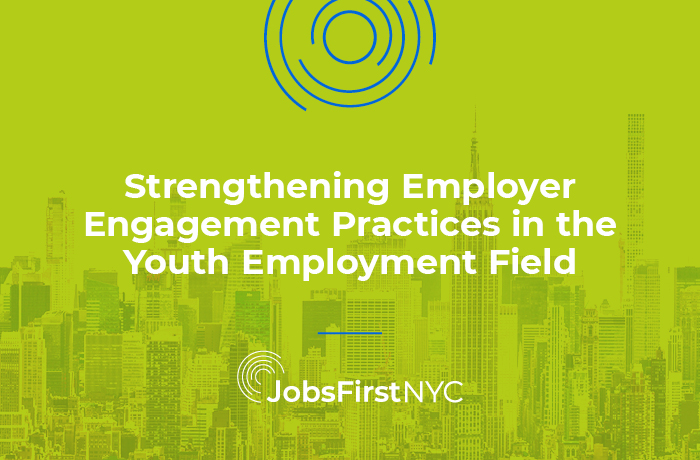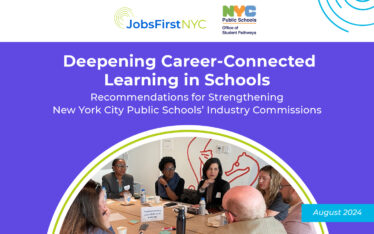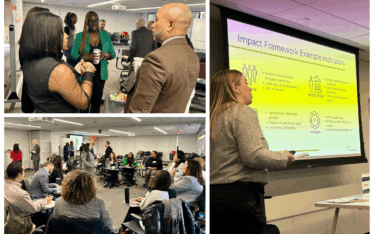Strengthening Employer Engagement Practices in the Youth Employment Field
by: Lou Miceli
There has been much recent discussion in our field around “cracking the code” of effective employer engagement. Employers have many options for filling positions, and workforce organizations often struggle to build the relationships that lead even to semi-regular hiring, much less continual placement of low-income job seekers. Making progress in this work can be slow-going for workforce organizations and programs, as it is often a challenging feat to connect to employers who best understand the needs of the people we serve, have a clear institutional value-proposition in terms of services they can provide to meet those needs, and are willing to make a commitment to support and prepare job seekers to be best matched to available employment opportunities. It can even be more challenging to do this consistently over time and with the quality necessary to benefit both employers and providers.
Challenges differ but are no less significant when we move beyond transactional job placements to look at the system-wide framework in which workforce development operates. These systemic challenges include: achieving scale to truly meet the needs of job seekers and employers, operating within the shifting political constraints, and fostering the relatively limited capacity of effective employer intermediaries that can help align workforce, training, and talent needs.
Throughout my career, I have held many roles in workforce and youth development. Some of my earliest were that of a job developer and a supervisor of job development, and then later as a trainer and mentor to many job developers. It is with those experiences in mind that I approach both the systemic and transactional elements of employer relationship-building in my own work at JobsFirstNYC, and which are central to our work overall in the workforce field.
Over the years, the training pendulum has swung from supply-side to demand-side focus on employer needs. This transition has been necessary and right. In an ideal world, individual organizations would collaborate to share resources and expertise to better meet the needs of bigger employers, thereby benefitting everyone involved. However, I still experience our work in the field as less coordinated and strategic than it should be, partially because fully-integrated employer engagement mechanisms are often complex, dynamic, and difficult to construct, especially in larger cities like New York where institutional individualism and political constraints are often well entrenched.
Employer engagement at the organizational or systems level is fundamentally about relationship-building and trust, often best taught through modeling and direct experience paired with training and effective practice exchange. This iterative process requires time. Organizations often make less-than-linear progress, and our field should build room to experiment with innovative approaches to doing this thoughtfully and well, while affording opportunities for errors and course-corrections.
Here are several steps the field can take to engage employers more effectively:
1. Strengthen the Role and Practice of Job Development
Job development represents a fundamental function for any workforce program, especially those with performance-based funding. Yet job development as a profession receives little formal attention. On the whole, job developers are underpaid, under-resourced and have surprisingly few opportunities for professional development. In a context where hiring standards are often low, stress to meet numbers is high, and turnover is endemic, it is difficult for organizations to develop sophisticated employer strategies. If we do not invest in this role, we will not see improvements in employer engagement at the transactional level.
Over the years, JobsFirstNYC has worked with Workforce Professionals Training Institute (WPTI) to convene thousands of job developers from across New York City and beyond to share effective practices and strategies, learn from field experts, and network directly with employers. WPTI is one of a handful of organizations we know of nationally that actually provides low-cost, high-quality training for job development staff. We need more examples of this kind of professional development in our field overall.
2. Strengthen and Support Job Development Supervisory Staff
Most job developers learn the skills of job development on the job. If you were like me and many of my colleagues, once you had some experience and reasonable success in working with employers, chances are you got promoted in your role, continuing to work with employers directly, but also supervising others doing the same.
Front-line job development is tough enough given pressures of meeting placement goals on performance-based contracts, but job development supervisors must also be adept at mentoring others while honing their own leadership and management skills. Supervisors must juggle contract / funder obligations and outcome expectations (often across multiple funding streams) while cultivating, leading, and sustaining a high-performing team. This is no small set of tasks, and like job developers themselves, little exists in terms of professional development or training to help develop and refine these skills. Supervisors also learn on the job, a process that inflicts significant opportunity costs on programs and organizations given high levels of turnover and attrition.
Supervisors of job developers should be trained to lead effective teams. This includes building their own leadership teams, creating effective account management teams, and using team approaches to continuously support and strengthen staff. Team work in employer engagement is crucial to transcend the old school mentality of “I keep my employer contacts in a locked safe,” and enables organizations to provide a more seamless set of services over time for any employer based relationship. As we develop such teams, we also need to be mindful about how such teams are incentivized and credited for shared job fulfillment efforts. There are interesting models we can learn from, especially from high-performing direct service providers.
3. Transcend Individual Connections
I often hear concerns from workforce leaders about just how challenging it is to sustain employer relationships when people on either side make transitions. If a job developer leaves and relationship goes with him or her, the organization is back to square one with that employer. Given that staffing changes and attrition are inevitable, I am surprised that there is not more discussion and writing about this phenomenon in our work. We need to do more to lift up examples of favorable solutions and workarounds.
The account management model is one relatively simple way to minimize institutional learning loss, especially for larger organizations. “When the phone rings, anyone on the team should be able to pick up the line and help the customer” is a long-established mantra in the sales world, and one our field could learn from. While one cannot always control for changes in HR leadership — and yes, even if you have a relationship with the CEO of the company, it does not mean that will be the go-to person who will be responsible for managing the relationship on the employer side — one can control for changes on the workforce side by training and supporting small teams of account managers to work together in a shared strategy.
4. Create and Leverage Board-Level Relationships
In recent years we have seen an increase in board-level involvement in organizational efforts to engage employers, and I believe that there needs to be much more of this in our field. For community-based organizations, there is a understandable challenge in doing this well given that many are led by boards that represent many issue areas and disciplines relevant to the mission of the organization, which may be more expansive and varied than just workforce training or job placement.
The best workforce organizations not only recruit business leaders at the board level, but also leverage those relationships to ensure the resources and connections they bring have maximal impact on the organization. While the door-opener for this may be commonly through corporate social responsibility, it can evolve to incorporate an integrated strategy where such relationships are leveraged to bring many different types of benefits to workforce organizations.
A thought on employer advisory boards: I am yet to see more than a handful of truly impactful organization-specific employer boards or advisory groups. Most that I have had direct experience with are in name only, or struggle with focus and enthusiasm. Employer advisory boards can be difficult to sustain for many reasons, but what I learn most commonly from employers is that the direct service organization cannot meet the scale or variety of talent needs required over time; that limitation impacts whether employers are willing or able to stay involved.
5. Build Multi-Organizational Collaborations
Perhaps one of the most promising ways to realize value for employers is through collaborative partnerships. In my years at JobsFirstNYC, we have helped develop several such initiatives, and have benefitted from the innovative and inclusive work that organizations can do when they bring together complementary capacities, resources, personnel, and data.
This is especially true for cracking the hiring processes of medium and larger sized employers, where staffing needs may be variable, customized, and at greater scale than any individual organization can meet alone. It is this type of strategy that has helped to make a national model of the Lower East Side Employment Network (LESEN), whose members have a keen sense of what they can and cannot deliver and work collaboratively to create a more organized, comprehensive approach to sourcing talent.
Through another collaborative, the Young Adult Sectoral Employment Project, we are beginning to see very creative and effective ways to meet employer talent needs that transcend the typical set of services that workforce organizations can provide. YASEP brings together CBOs and employers to craft specific training programs to create a pipeline of highly qualified candidates for specific positions in high-growth fields. Employers benefit from involvement in pre-hire preparation, and workforce organizations see high placement rates. This project has become a national model.
The goal of workforce development is to remove the barriers that keep low-income job seekers out of the labor market. Ultimately, meeting the demands for our services means embracing the needs of employers as much as job seekers – and engaging employers in a way that leads to repeat, frequent hiring over the long term. Without fundamental changes to the way most job development happens, we may fall short.




